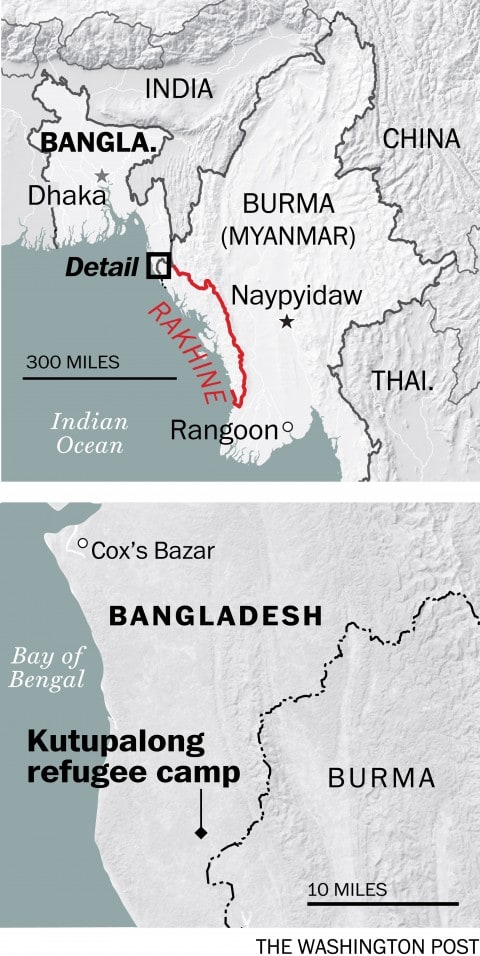Under Siege in Their Villages, Rohingya Still In Burma Say They’re Trapped
SPOTLIGHT, 9 Oct 2017
Max Bearak – The Washington Post
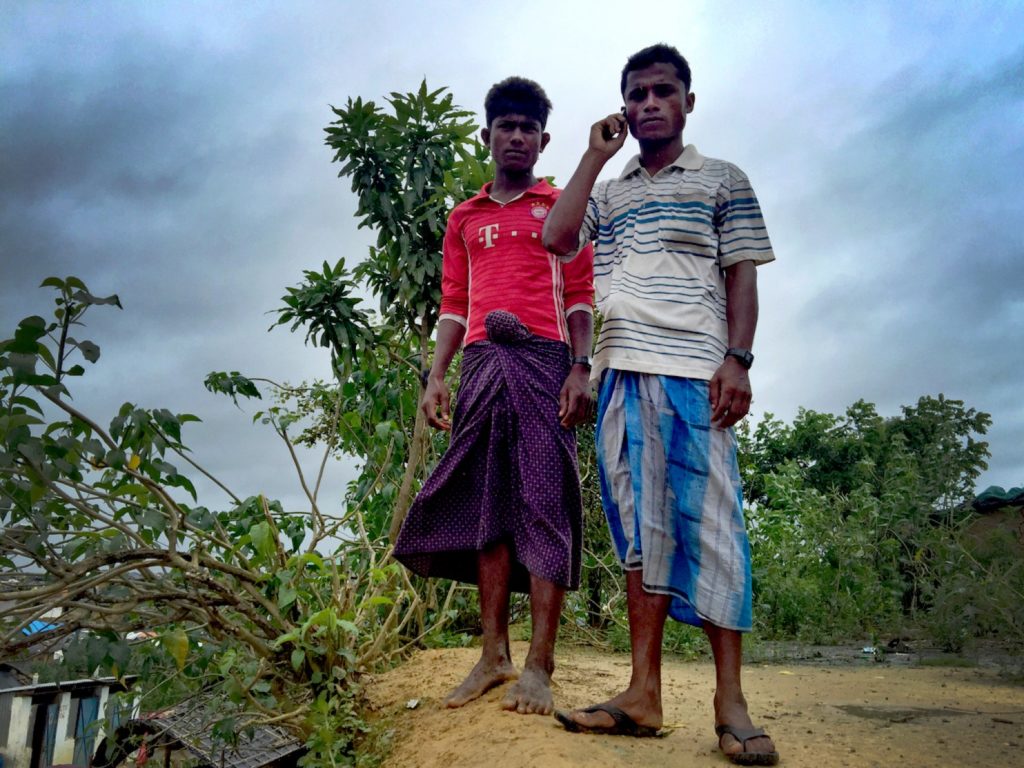
Sayid Alam and his childhood friend Mohammad Shafi, both 19, stand in one of the three spots in the Kutupalong refugee camp where Burmese cell service is available.
(Max Bearak/The Washington Post)
2 Oct 2017 — Aung San Suu Kyi, Burma’s de facto leader, recently claimed that an unprecedented exodus of half a million Rohingya Muslims from her country in just five weeks “has quieted down” and that people are “carrying on as normal.”
The Burmese government has locked down troubled Rakhine state, blocking independent access to media and aid organizations. But there is another, albeit less precise, way to assess the ground reality for Rohingya in Burma: calling them on their cellphones.
Testimony gathered last week from more than a dozen such conversations suggests that Burma’s leaders are either misinformed about events in Rakhine or intentionally misrepresenting them.
Since Rohingya militants attacked Burmese police posts on Aug. 25, the Burmese military has swept through northern Rakhine in “cleansing operations” it says are aimed at eliminating terrorists. The United Nations has called it a “textbook example of ethnic cleansing.” Rohingya have fled that scorched-earth campaign at a rate not seen since the Rwandan genocide in 1994, although the flow has slowed over the past two weeks. Now more Rohingya live in severely overburdened camps in Bangladesh than they do in Burma.
The people contacted by or in the presence of a Washington Post reporter were at various stages of peril. Some were in a Rohingya village under siege, where anyone who tries to sneak out is reportedly gunned down. People there are beginning to starve. Others were among thousands stranded on a beach in the village of Alel Than Kyaw, corralled by the Burmese military while waiting for boats to take them to Bangladesh.
The Post cannot independently verify these claims because of the lockdown in Rakhine state. But the accounts, which are in line with interviews done by human rights organizations as well as satellite imagery, indicate that the Rohingya exodus is far from over.
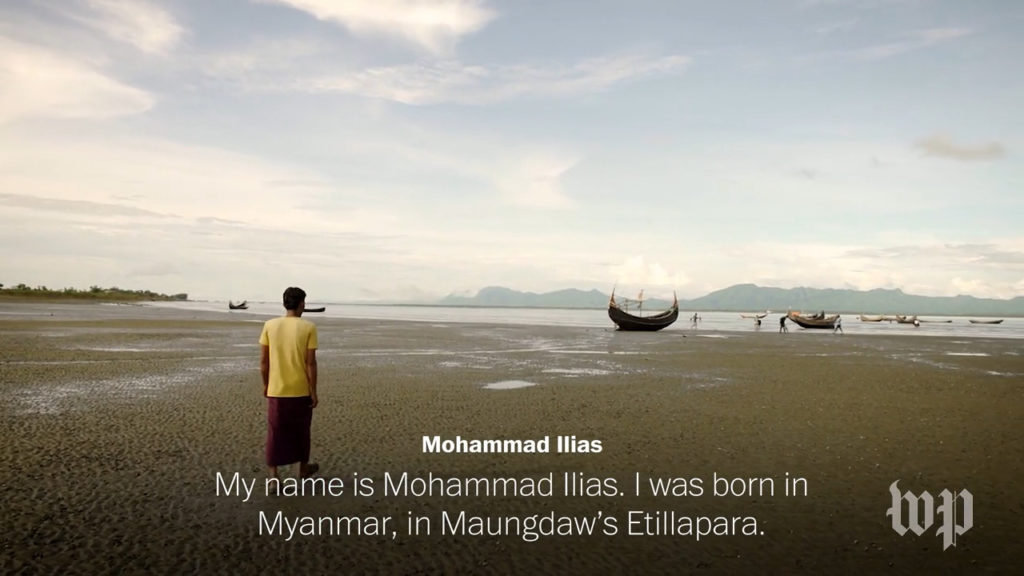
Mohammad Ilias, a Rohingya Muslim refugee, escaped from Burma after its security forces began burning down his village on Aug. 26. In the chaos, he was separated from his mother. A week later, he went back for her. [Screenshot]
(Maher Sattar, Joyce Lee/The Washington Post)
Only three tiny spots in this sprawling expanse of tents in Bangladesh offer access to a few bars of Burmese cell service. Rohingya refugees who’ve been at the camps for decades — since earlier waves of violence — have shown the new arrivals exactly where to stand to make calls. Streams of people gather there, clutching scratched-up phones, sometimes laughing, often crying.
The calls are laden with anxiety. Each holds the possibility of heartbreak.
When a call to Shazia Alam finally went through on Thursday, the sound of babies wailing reverberated as she said hello through a speakerphone. She was with about 400 people from her village, on a steep hillside near the Burmese coast, with a rain-swollen river in the valley below. The chance of catching a boat from Alel Than Kyaw to Bangladesh was just a half-day’s walk ahead, but they’d heard the military was there. After all they had seen, they were avoiding uniformed men at all costs.
Their village in Rathedaung township, Tar Zaw, was torched three weeks ago, she said, and its residents had sought shelter in other Rohingya villages not yet “visited” by the military. But the soldiers and their accompanying mobs of local Buddhists were never far behind. Last Tuesday, in their third village, elders made the decision to leave Burma for good. They’d all been walking since then. And now they were stuck.
“The only food we have is uncooked rice, and we can’t boil it because we have no roof to be under, no dry wood. No one has eaten since yesterday. It has been raining so, so hard,” she said. She began to sob. “There are snakes everywhere here.”
“We have no money at all to pay a boatman even if we do survive this,” she said. “Please help us.”
Her 19-year-old son, Sayid, listened helplessly to her voice. He had fled to Bangladesh three years ago after being beaten by Burmese military officers. He’d missed his mother before but said the past two weeks had been excruciating as he struggled to find the means to call her as often as possible. Spending the dollar it costs to buy the smallest package of minutes for his cellphone might mean skipping meals.
“Sometimes there is no signal,” he said. “Other times, it’s hard to find Burmese top-up cards. But most of the time, there’s just no money.”
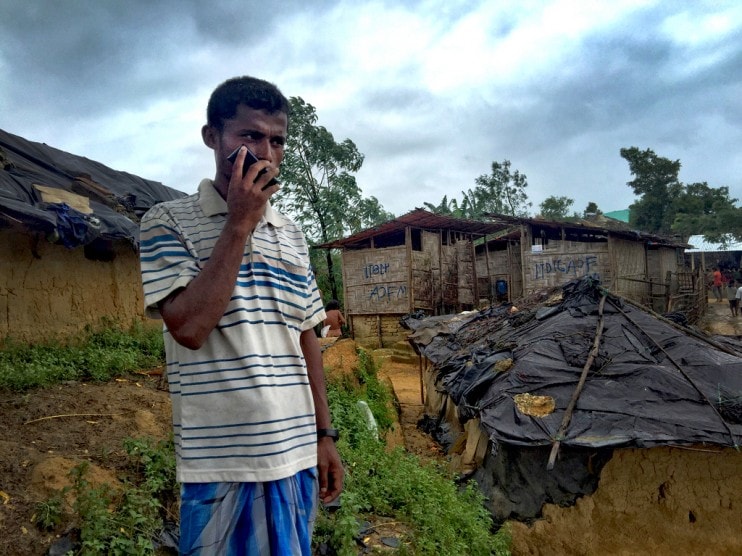
Sayid Alam, 19, speaks with his mother, Shazia, who is still in Burma and is attempting to flee to Bangladesh.
(Max Bearak/The Washington Post)
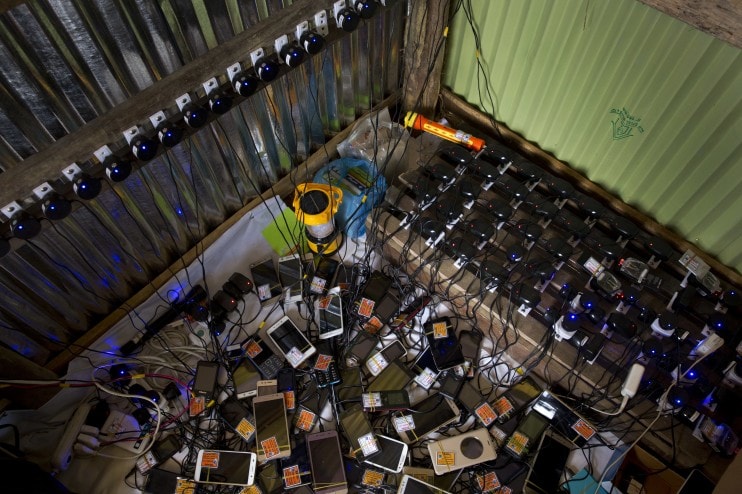
Dozens of cellphones charge in a makeshift shop for a price of five taka (6 cents), in Lambashia, near Kutupalong.
(Bernat Armangue/Associated Press)
Although the flow of Rohingya started to slow about two weeks ago, recent satellite imagery shows a mass of people camping at Alel Than Kyaw, probably numbering in the thousands. Most are from Buthidaung and Rathedaung townships. The first month’s influx came mostly from Maungdaw township, where
Reuters reporters found all but one Rohingya village reduced to smoldering ash in early September.
On Thursday night, more than 60 people drowned when an overloaded boat from Alel Than Kyaw capsized just minutes from reaching the Bangladeshi coast. Most of the dead were women and children.
“The soldiers told us that if we try to leave Burma, they will shoot us,” said Dilpurukh, an elderly woman who made the crossing the night before the capsizing. Like many Rohingya, she goes by one name. “We only slipped away when the officers started to drink their alcohol after dark. There is one place by the water where you can get Bangladesh mobile network and we called a boatman and begged him to come.”
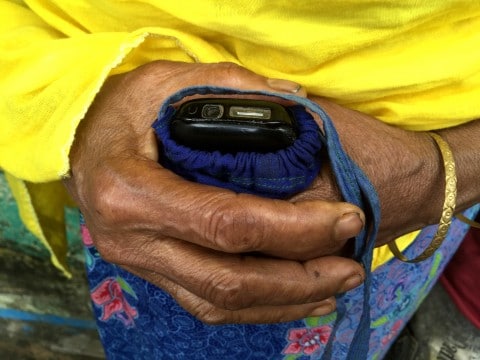
Dilpurukh clasps the phone that she managed to hide from Burmese military officers when she and hundreds of others were rounded up on Wednesday. She crossed to Bangladesh by boat later that day.
(Max Bearak/The Washington Post)
That the Burmese military is trying to turn back Bangladesh-bound Rohingya is a new dynamic. Since the exodus began on Aug. 25, Burma’s goal had appeared to be the expulsion of the Rohingya, whom it considers illegal interlopers from Bangladesh.
Both Matt Wells, senior crisis adviser at Amnesty International, and Chris Lewa, director of the Arakan Project, said they had heard reports of Rohingya being forcibly prevented from fleeing. Burmese state media has touted the decision, saying authorities have promised to provide food and transportation to villages. Whether Rohingya would be safe turning back, and whether their villages even exist anymore, are big unknowns.
“Internally displaced Bengalis, they can return home and the government will provide their needs to build and reconstruct their homes,” said Zaw Htay, a spokesman for Suu Kyi’s office, using the government’s preferred term for the Rohingya. “The government will provide food and other necessary aid.”
Cooped up in the Burmese township of Buthidaung, a Rohingya religious scholar scoffed at the idea that the government had suddenly become compassionate. Rather, he said, it has realized that Rohingya refugees in Bangladesh are exposing atrocities in Rakhine and tarnishing Burma’s image. He spoke on the condition of anonymity because he interacts with Burmese military officers regularly and did not want to jeopardize his safety.
“In the city, the military comes around on patrol. They say, ‘The ones who’ve fled are bad people who just want to make a bad name for Burma,’ ” he said. “They say, ‘You stay, you are the good ones.’ But then they interrogate us about Rohingya militants. We’ve heard of a Rohingya army, but I’ve never seen them with my own eyes. No, not even in my dreams have I seen them, I swear to God.”
As dire as others’ circumstances were, they seemed enviable to Mohammad Arif, speaking by phone from the Rohingya village of Sin Gyi Pyin, in central Rakhine’s Minbya township, far from the epicenter of the crisis in the north. Lewa, of the Arakan Project, said that the situation in central Rakhine had been tense since August, too, and that outside organizations had little to no access. The Post spoke with two others from Sin Gyi Pyin who repeated Arif’s claims.
“There are some very wealthy families in our village and together they put together enough money to bribe the military so that they wouldn’t burn our village. But now it is the Buddhist people from the nearby villages who have us surrounded. If anyone gets caught leaving, they are killed immediately,” said Arif, listing the names and approximate ages of 13 men and one woman who he said had met that fate. “The ones who are risking it are the poorest people, who are starting to starve. My family’s stock of food is getting low, so we’ve had to stop sharing with the poor. Ten of us are eating a serving of rice that used to feed one person.”
The line went near-silent for almost a minute as Arif wept.
“Do you understand? We’re surrounded from all four sides. We would have to sneak out and stay hidden for days to escape. Last year, when there was violence, the military would take bribes from us and buy us food from the market. But this year it is different,” he said. “Our only hope is that they will take pity. Otherwise, this is how we die.”
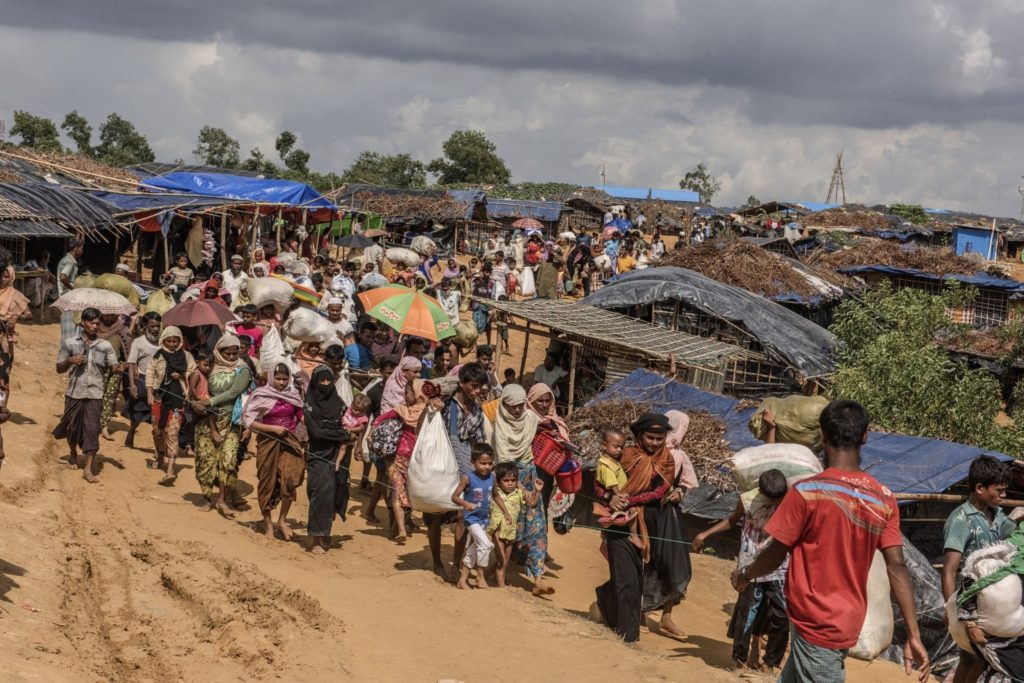
Rohingya refugees make their way to permanent tents in the Kutupalong refugee camp in Bangladesh.
(Ismail Ferdous/Bloomberg News)
____________________________________________
Read more:
How Bangladeshis are coping with half a million new Rohingya refugees
 Max Bearak writes about foreign affairs for the Washington Post. Previously, he reported from South Asia for the New York Times and others.
Max Bearak writes about foreign affairs for the Washington Post. Previously, he reported from South Asia for the New York Times and others.
Joe Freeman in Rangoon contributed to this report.
Go to Original – washingtonpost.com
DISCLAIMER: The statements, views and opinions expressed in pieces republished here are solely those of the authors and do not necessarily represent those of TMS. In accordance with title 17 U.S.C. section 107, this material is distributed without profit to those who have expressed a prior interest in receiving the included information for research and educational purposes. TMS has no affiliation whatsoever with the originator of this article nor is TMS endorsed or sponsored by the originator. “GO TO ORIGINAL” links are provided as a convenience to our readers and allow for verification of authenticity. However, as originating pages are often updated by their originating host sites, the versions posted may not match the versions our readers view when clicking the “GO TO ORIGINAL” links. This site contains copyrighted material the use of which has not always been specifically authorized by the copyright owner. We are making such material available in our efforts to advance understanding of environmental, political, human rights, economic, democracy, scientific, and social justice issues, etc. We believe this constitutes a ‘fair use’ of any such copyrighted material as provided for in section 107 of the US Copyright Law. In accordance with Title 17 U.S.C. Section 107, the material on this site is distributed without profit to those who have expressed a prior interest in receiving the included information for research and educational purposes. For more information go to: http://www.law.cornell.edu/uscode/17/107.shtml. If you wish to use copyrighted material from this site for purposes of your own that go beyond ‘fair use’, you must obtain permission from the copyright owner.
